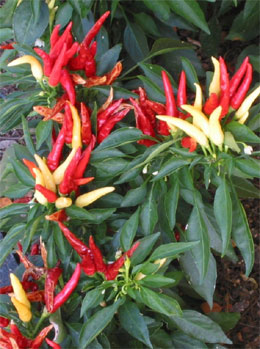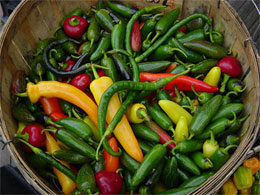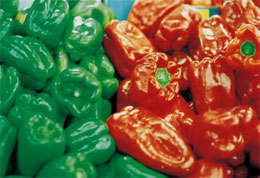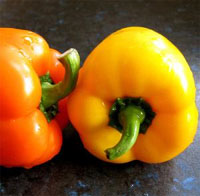
Capsicum spp.
Chillies would have to be about the greatest things on earth (okay, slight exaggeration, but they are pretty awesome!) I love chillies so much I have driven for two hours just to get one dipped in amazing Belgian dark chocolate. Apart from combining my two favourite foods, this is a taste sensation that must be experienced by everyone at least once. For those of you who can’t fathom the idea, I am considering setting up an offset scheme, where you pay me to eat your share of chilies dipped in chocolate. Well, it sounds like a good idea to me!
Planting Schedule
Warm: All year (in frost free zones)
Temperate: August – December
Cool: September – November
Position, Position, Position!
Capsicums and chillies are so easy to grow that I have never had a Yummy Yard without them. That said, it has a lot to do with picking a great position. Just like their cousins the tomatoes, they need a warm, sunny spot that is not too affected by the wind. They are total sooks when it comes to frost and in cool areas they tend to die back over winter and re-shoot in spring. In areas with really, really hot summers, a wee shadecloth tent may be exactly the thing for these guys. I use between a 30% – 50% shadecloth, and consequently have no problem with sun scald or fruit set.
One other thing to remember is that both capsicums and chillies can be grown in pots and containers. In fact, I have given chillies in decorative pots as Christmas gifts for as long as I can remember (I really must put a little more thought in this year). Point is, they’re virtually fool proof, look amazing and are so great in pots.
Another thing to remember is that because chillies and capsicums are related to tomatoes, eggplants and potatoes, it’s important to rotate these crops. Leave about three years between planting any of these guys in the same patch. See my hot tip for a great idea to overcome this.

Talking Dirty
Like their close relations, chillies and capsicums will do best in a deep, well draining soil with a bit of compost in it. That said, I have seen capsicums do well in really clay soils and in sandy soils. The secret to their success is warm soil, mulch and room to breathe. Leave about 50cm – 60cm between your capsicums when planting out, as this gives them space and free air movement. It also allows the sun to warm the soil. Prepare the soil a month before planting by throwing in a bit of pelletised chook poo. Then mulch over and count down the days.
Feed Me!
Feeding these guys is fraught with danger, and is often totally unnecessary. If you must feed, make sure you don’t do it with a high nitrogen fertiliser. This will turn your plants into big, green wimps, with heaps of sooky leaves and no fruit. Generally speaking, manufactured fertilizers are too high in nitrogen which damages both the plant and the environment. Give ’em a bit of pelletised poo blend when the fruit first forms, and repeat this each month… that’s it!
What about the Water?
Capsicums are deep-rooted, but this doesn’t mean you don’t have to water them. They need regular, deep soakings of water which will vary depending on your soil type. Sandy soils need more water, clay soils less, and combo soils are somewhere in between. Confused? Don’t be afraid to stick your finger into your soil and check your moisture levels. If the dirt sticks, the soil is damp. If it doesn’t, water well!!!

Are We There Yet?
Chillies are perfect for both the impatient gardener (me) and the lazy gardener (also me), in that they can be picked at just about any time. In fact, you can leave them on the bushes until they shrivel, and them thread them on some string (or dental floss, which works well as a string substitute in a student share house). Chillies at all stages of maturity can be eaten, and the more you pick, the happier your chilli plant will be.
Capsicums are not quite as simple, but they are pretty close. They can be picked at just about any time, but should never be left on the plant too long as over ripe capsicums become rank and attract pests. It should be noted here that many people find fully-ripe capsicums easier to digest than green ones (I have no idea how or why I know that, but it is true).
And, with both chillies and capsicums, cut them off the plant when you harvest them instead of pulling them off… this hurts the plant and breaks my heart!
Pests and the Rest
Chillies are amazingly pest free, due to the fact that most pests don’t seem to like chilli. Capsicums can be susceptible to blossom end rot and fruit fly, and can suffer sunburn like a redhead on the Gold Coast! I have to say that I reckon chilies and capsicums are so trouble free, even my mum could grow them.

Hot Tips
My hot tip here relates to crop rotation, relations and disease avoidance. But this is not always a popular tip so take from it what you will. My suggestion is to plant a realistic but limited selection of tomatoes, capsicums, eggplants and chillies together each season. Then rotate them in this formation every year thereafter. I mean, you only need two chillies, two eggplants, three capsicums and four or five tomatoes to have a superbly productive patch. And I personally reckon this is the best way to manage crop rotation. After all, a family that rotates together stays together (or something like that).
Oh, and one other… if you do happen to try the divine chilli-chocolate combination, or any other chilli dish, and find the little devils too hot, always have a drink of milk instead of water!
Eat Me
Chilli Sauce
4 Birdseye chillies
3 tbsp vegetable oil
1 onion
2 cloves garlic
½ tsp allspice
1 tsp sugar or honey
2 homegrown tomatoes or ½ cup preserved homegrown tomatoes
¼ tsp salt
Put chillies and 350 ml water in a saucepan. Bring to the boil then simmer for 5 minutes. Save the water. Chop the chillies.
Fry onion and garlic in oil. Add allspice, salt, sugar, tomato, and chopped chillies and chilli water. Simmer until reduced and thick.
Serve with Mexican but will also blow your socks off with Lebanese, on wraps and sandwiches, with barbecued meat, baked fish etc.
One Two Three Ratatouille
This makes enough for a very large feast of fresh, homegrown vegetables. You can easily half it to make enough to serve 2 people.
1 eggplant
2 onions
2 cloves garlic
2 red capsicums
2 zucchini
2 tbsp tomato paste
2 cups tomatoes
2 tbsp freshly picked herbs
3 tbsp olive oil
Chop all vegetables into even sized chunks.
Crush garlic
Place one tbsp oil into a large mixing bowl. Add eggplant and toss until coated with the oil.
Heat a large wok, deep frypan or wide saucepan over high heat.
Add eggplant to the pan. Try not to stir the eggplant too much but turn it methodically with tongs so it browns on all sides. Place a lid on the pan between each time you turn the eggplant.
When the eggplant is tender and soft, remove and set aside. Leave the pan on the heat as the zucchini is coming next.
Place the zucchini in the large mixing bowl with another tbsp oil and toss. Fry the zucchini as you did the eggplant. Remove it and place it with the eggplant.
Place the onion and capsicum in the large mixing bowl with remaining oil. Toss to combine.
Fry the onion and capsicum until soft and tender. Add the garlic and tomato paste and stir for one minute. Add the tomatoes. When mixture boils, place zucchini and eggplant back in to the saucepan. Bring to boil again and reduce heat to a simmer.
Simmer until tomato thickens.
Season, and stir through chopped fresh herbs and serve with either cous cous, polenta, rice, potatoes, pasta etc
So simple, yet tastes so good using freshly picked herbs and home grown vegies.
Related Articles:
Garden Journaling – Slow down to tune in.
As we move through the year and our gardens evolve, there's something magical about documenting the journey. Garden journaling is an art that enables…
The Importance of building soil health for a biodeverse, productive garden
Creating a thriving garden that not only sustains itself but also contributes to the broader ecosystem requires more than just sunlight and water.…




